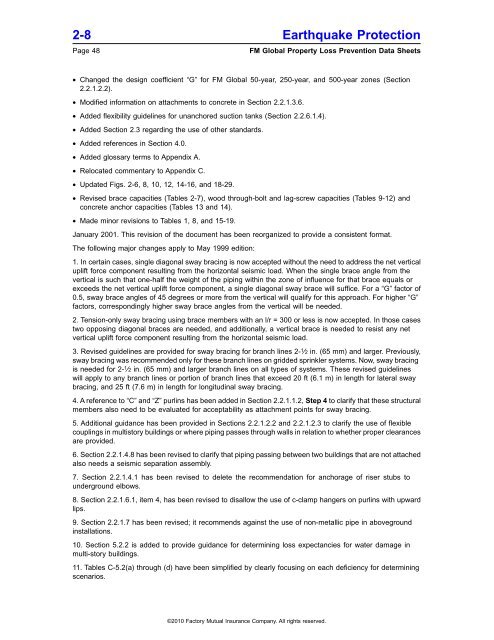DS 2-8 Earthquake Protection for Water-Based Fire ... - FM Global
DS 2-8 Earthquake Protection for Water-Based Fire ... - FM Global
DS 2-8 Earthquake Protection for Water-Based Fire ... - FM Global
You also want an ePaper? Increase the reach of your titles
YUMPU automatically turns print PDFs into web optimized ePapers that Google loves.
2-8 <strong>Earthquake</strong> <strong>Protection</strong><br />
Page 48 <strong>FM</strong> <strong>Global</strong> Property Loss Prevention Data Sheets<br />
• Changed the design coefficient “G” <strong>for</strong> <strong>FM</strong> <strong>Global</strong> 50-year, 250-year, and 500-year zones (Section<br />
2.2.1.2.2).<br />
• Modified in<strong>for</strong>mation on attachments to concrete in Section 2.2.1.3.6.<br />
• Added flexibility guidelines <strong>for</strong> unanchored suction tanks (Section 2.2.6.1.4).<br />
• Added Section 2.3 regarding the use of other standards.<br />
• Added references in Section 4.0.<br />
• Added glossary terms to Appendix A.<br />
• Relocated commentary to Appendix C.<br />
• Updated Figs. 2-6, 8, 10, 12, 14-16, and 18-29.<br />
• Revised brace capacities (Tables 2-7), wood through-bolt and lag-screw capacities (Tables 9-12) and<br />
concrete anchor capacities (Tables 13 and 14).<br />
• Made minor revisions to Tables 1, 8, and 15-19.<br />
January 2001. This revision of the document has been reorganized to provide a consistent <strong>for</strong>mat.<br />
The following major changes apply to May 1999 edition:<br />
1. In certain cases, single diagonal sway bracing is now accepted without the need to address the net vertical<br />
uplift <strong>for</strong>ce component resulting from the horizontal seismic load. When the single brace angle from the<br />
vertical is such that one-half the weight of the piping within the zone of influence <strong>for</strong> that brace equals or<br />
exceeds the net vertical uplift <strong>for</strong>ce component, a single diagonal sway brace will suffice. For a “G” factor of<br />
0.5, sway brace angles of 45 degrees or more from the vertical will qualify <strong>for</strong> this approach. For higher “G”<br />
factors, correspondingly higher sway brace angles from the vertical will be needed.<br />
2. Tension-only sway bracing using brace members with an l/r = 300 or less is now accepted. In those cases<br />
two opposing diagonal braces are needed, and additionally, a vertical brace is needed to resist any net<br />
vertical uplift <strong>for</strong>ce component resulting from the horizontal seismic load.<br />
3. Revised guidelines are provided <strong>for</strong> sway bracing <strong>for</strong> branch lines 2- 1 ⁄ 2 in. (65 mm) and larger. Previously,<br />
sway bracing was recommended only <strong>for</strong> these branch lines on gridded sprinkler systems. Now, sway bracing<br />
is needed <strong>for</strong> 2- 1 ⁄ 2 in. (65 mm) and larger branch lines on all types of systems. These revised guidelines<br />
will apply to any branch lines or portion of branch lines that exceed 20 ft (6.1 m) in length <strong>for</strong> lateral sway<br />
bracing, and 25 ft (7.6 m) in length <strong>for</strong> longitudinal sway bracing.<br />
4. A reference to “C” and “Z” purlins has been added in Section 2.2.1.1.2, Step 4 to clarify that these structural<br />
members also need to be evaluated <strong>for</strong> acceptability as attachment points <strong>for</strong> sway bracing.<br />
5. Additional guidance has been provided in Sections 2.2.1.2.2 and 2.2.1.2.3 to clarify the use of flexible<br />
couplings in multistory buildings or where piping passes through walls in relation to whether proper clearances<br />
are provided.<br />
6. Section 2.2.1.4.8 has been revised to clarify that piping passing between two buildings that are not attached<br />
also needs a seismic separation assembly.<br />
7. Section 2.2.1.4.1 has been revised to delete the recommendation <strong>for</strong> anchorage of riser stubs to<br />
underground elbows.<br />
8. Section 2.2.1.6.1, item 4, has been revised to disallow the use of c-clamp hangers on purlins with upward<br />
lips.<br />
9. Section 2.2.1.7 has been revised; it recommends against the use of non-metallic pipe in aboveground<br />
installations.<br />
10. Section 5.2.2 is added to provide guidance <strong>for</strong> determining loss expectancies <strong>for</strong> water damage in<br />
multi-story buildings.<br />
11. Tables C-5.2(a) through (d) have been simplified by clearly focusing on each deficiency <strong>for</strong> determining<br />
scenarios.<br />
©2010 Factory Mutual Insurance Company. All rights reserved.

















